MGT603: System Thinking - Rich Picture, CATWOE Analysis Report
VerifiedAdded on 2022/10/12
|9
|1798
|129
Report
AI Summary
This report analyzes the inventory management issues faced by Kmart Australia using a system thinking approach. It begins with an introduction emphasizing the importance of efficient inventory management in the competitive business market. The report then executes a CATWOE analysis, identifying the Clients, Actors, Transformation, Worldview, Owners, and Environmental restrictions related to the problem. A rich picture is provided to visually represent the situation. Finally, the report offers recommendations for implementing a mobile inventory management system to improve product delivery and customer satisfaction. The analysis includes stakeholder perspectives and ethical considerations, supported by relevant references.
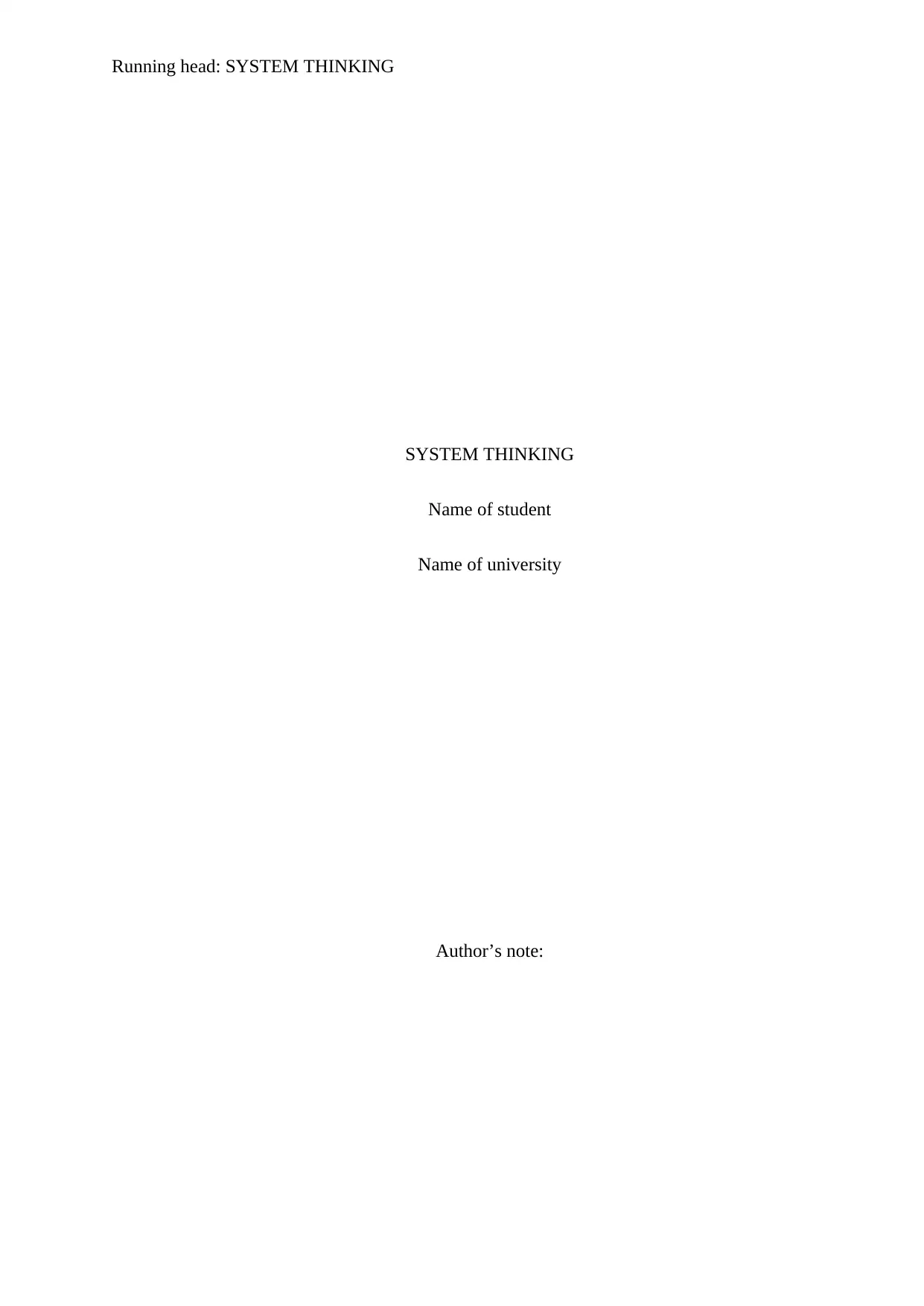
Running head: SYSTEM THINKING
SYSTEM THINKING
Name of student
Name of university
Author’s note:
SYSTEM THINKING
Name of student
Name of university
Author’s note:
Paraphrase This Document
Need a fresh take? Get an instant paraphrase of this document with our AI Paraphraser
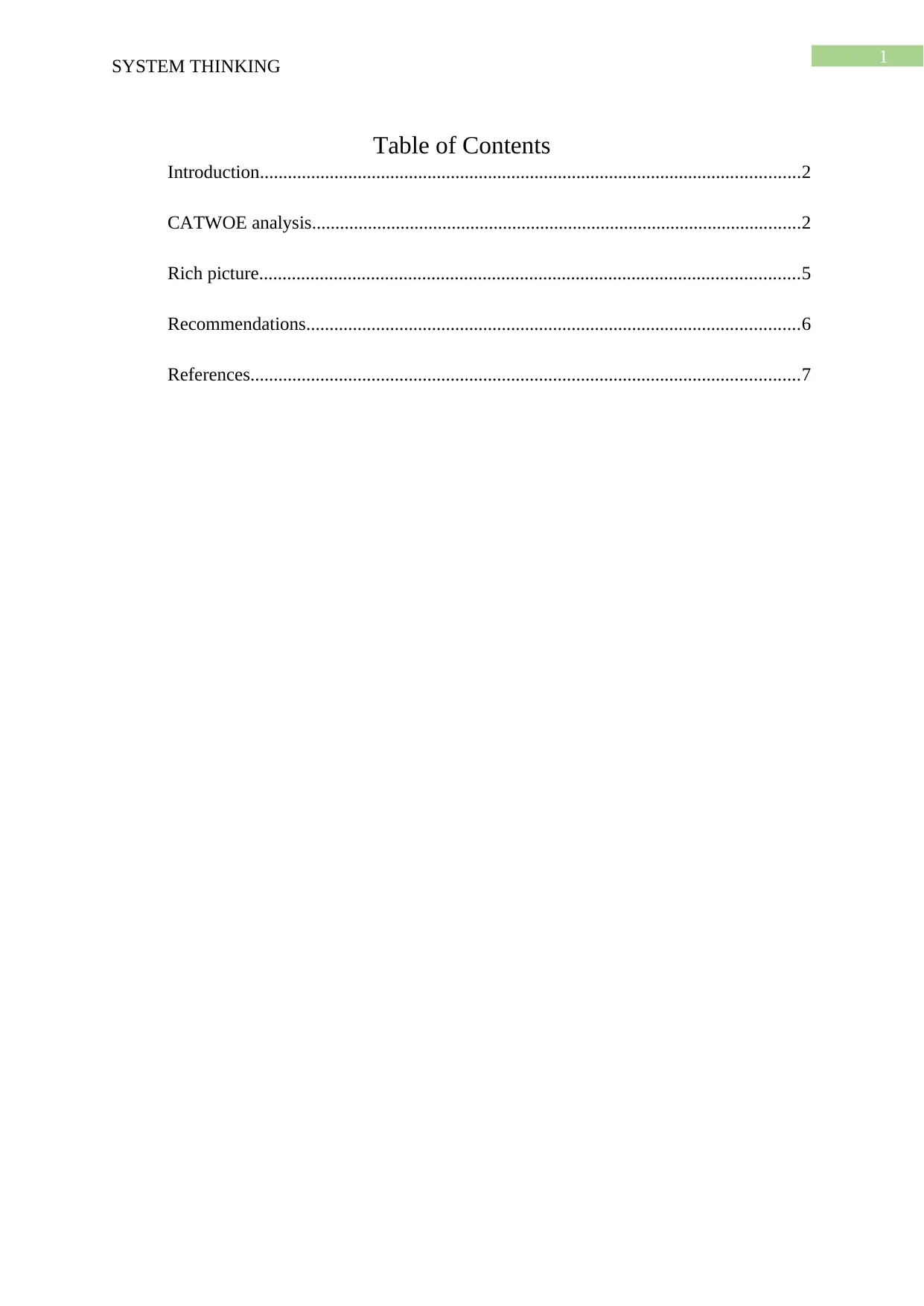
1
SYSTEM THINKING
Table of Contents
Introduction....................................................................................................................2
CATWOE analysis.........................................................................................................2
Rich picture....................................................................................................................5
Recommendations..........................................................................................................6
References......................................................................................................................7
SYSTEM THINKING
Table of Contents
Introduction....................................................................................................................2
CATWOE analysis.........................................................................................................2
Rich picture....................................................................................................................5
Recommendations..........................................................................................................6
References......................................................................................................................7
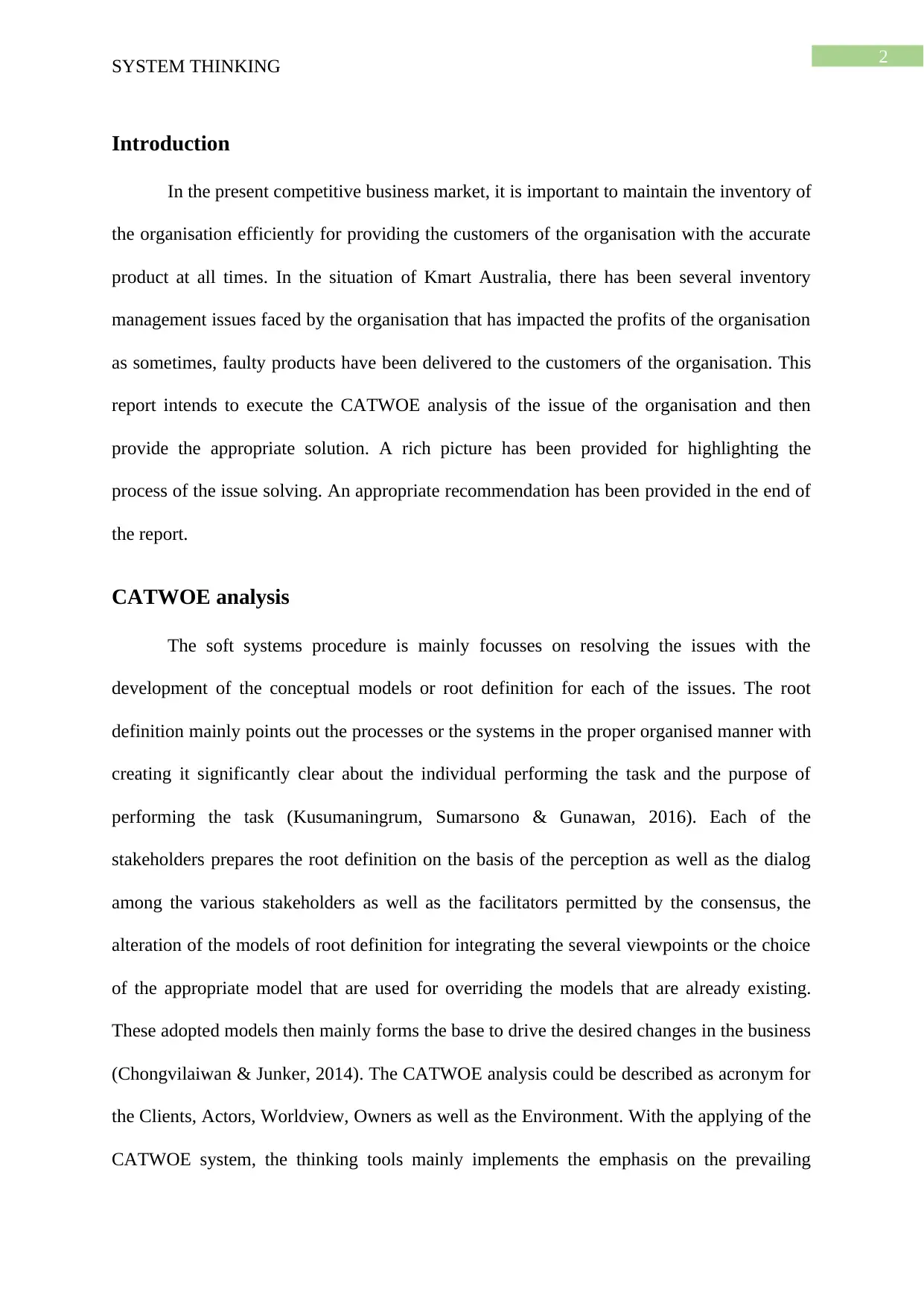
2
SYSTEM THINKING
Introduction
In the present competitive business market, it is important to maintain the inventory of
the organisation efficiently for providing the customers of the organisation with the accurate
product at all times. In the situation of Kmart Australia, there has been several inventory
management issues faced by the organisation that has impacted the profits of the organisation
as sometimes, faulty products have been delivered to the customers of the organisation. This
report intends to execute the CATWOE analysis of the issue of the organisation and then
provide the appropriate solution. A rich picture has been provided for highlighting the
process of the issue solving. An appropriate recommendation has been provided in the end of
the report.
CATWOE analysis
The soft systems procedure is mainly focusses on resolving the issues with the
development of the conceptual models or root definition for each of the issues. The root
definition mainly points out the processes or the systems in the proper organised manner with
creating it significantly clear about the individual performing the task and the purpose of
performing the task (Kusumaningrum, Sumarsono & Gunawan, 2016). Each of the
stakeholders prepares the root definition on the basis of the perception as well as the dialog
among the various stakeholders as well as the facilitators permitted by the consensus, the
alteration of the models of root definition for integrating the several viewpoints or the choice
of the appropriate model that are used for overriding the models that are already existing.
These adopted models then mainly forms the base to drive the desired changes in the business
(Chongvilaiwan & Junker, 2014). The CATWOE analysis could be described as acronym for
the Clients, Actors, Worldview, Owners as well as the Environment. With the applying of the
CATWOE system, the thinking tools mainly implements the emphasis on the prevailing
SYSTEM THINKING
Introduction
In the present competitive business market, it is important to maintain the inventory of
the organisation efficiently for providing the customers of the organisation with the accurate
product at all times. In the situation of Kmart Australia, there has been several inventory
management issues faced by the organisation that has impacted the profits of the organisation
as sometimes, faulty products have been delivered to the customers of the organisation. This
report intends to execute the CATWOE analysis of the issue of the organisation and then
provide the appropriate solution. A rich picture has been provided for highlighting the
process of the issue solving. An appropriate recommendation has been provided in the end of
the report.
CATWOE analysis
The soft systems procedure is mainly focusses on resolving the issues with the
development of the conceptual models or root definition for each of the issues. The root
definition mainly points out the processes or the systems in the proper organised manner with
creating it significantly clear about the individual performing the task and the purpose of
performing the task (Kusumaningrum, Sumarsono & Gunawan, 2016). Each of the
stakeholders prepares the root definition on the basis of the perception as well as the dialog
among the various stakeholders as well as the facilitators permitted by the consensus, the
alteration of the models of root definition for integrating the several viewpoints or the choice
of the appropriate model that are used for overriding the models that are already existing.
These adopted models then mainly forms the base to drive the desired changes in the business
(Chongvilaiwan & Junker, 2014). The CATWOE analysis could be described as acronym for
the Clients, Actors, Worldview, Owners as well as the Environment. With the applying of the
CATWOE system, the thinking tools mainly implements the emphasis on the prevailing
⊘ This is a preview!⊘
Do you want full access?
Subscribe today to unlock all pages.

Trusted by 1+ million students worldwide
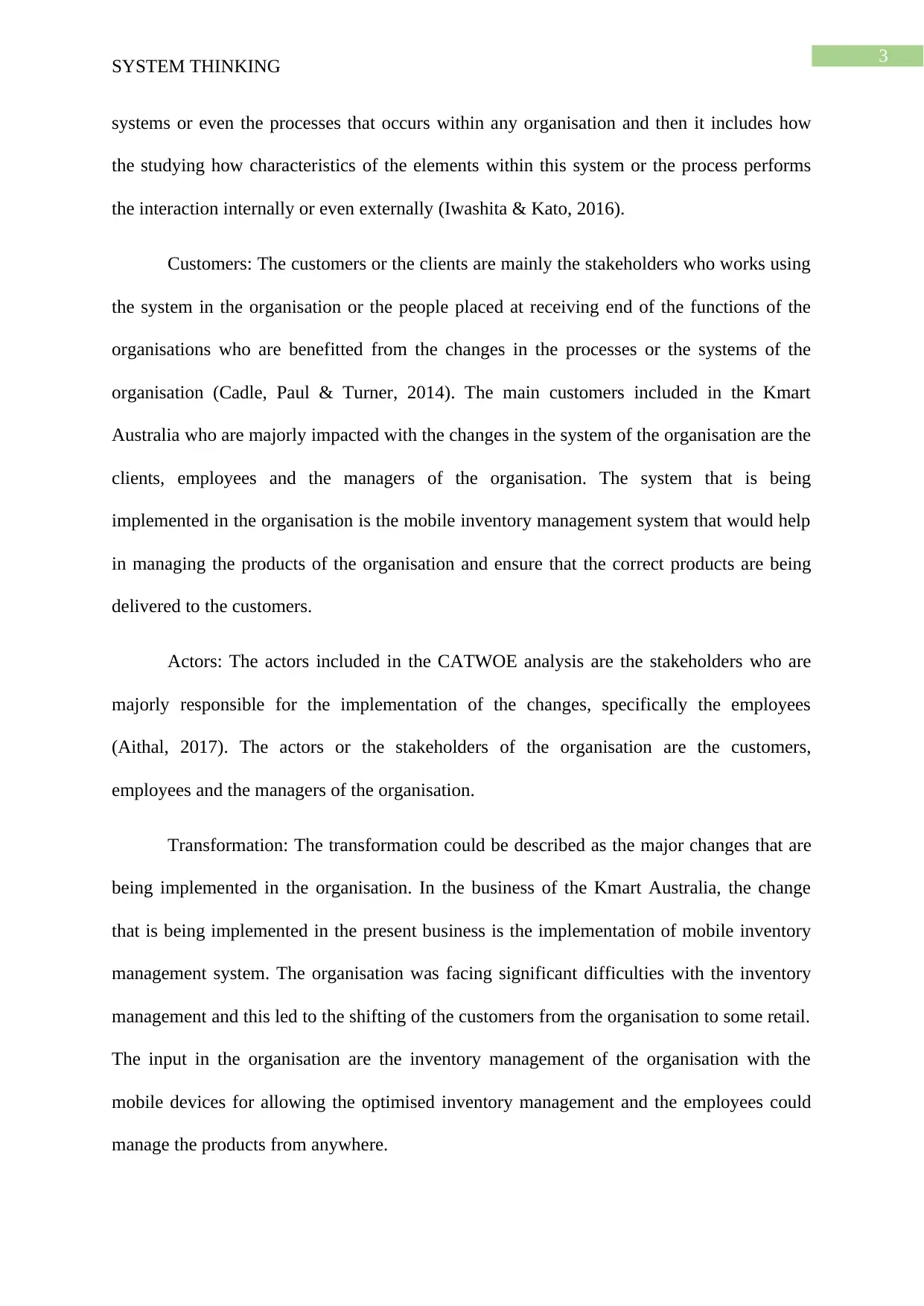
3
SYSTEM THINKING
systems or even the processes that occurs within any organisation and then it includes how
the studying how characteristics of the elements within this system or the process performs
the interaction internally or even externally (Iwashita & Kato, 2016).
Customers: The customers or the clients are mainly the stakeholders who works using
the system in the organisation or the people placed at receiving end of the functions of the
organisations who are benefitted from the changes in the processes or the systems of the
organisation (Cadle, Paul & Turner, 2014). The main customers included in the Kmart
Australia who are majorly impacted with the changes in the system of the organisation are the
clients, employees and the managers of the organisation. The system that is being
implemented in the organisation is the mobile inventory management system that would help
in managing the products of the organisation and ensure that the correct products are being
delivered to the customers.
Actors: The actors included in the CATWOE analysis are the stakeholders who are
majorly responsible for the implementation of the changes, specifically the employees
(Aithal, 2017). The actors or the stakeholders of the organisation are the customers,
employees and the managers of the organisation.
Transformation: The transformation could be described as the major changes that are
being implemented in the organisation. In the business of the Kmart Australia, the change
that is being implemented in the present business is the implementation of mobile inventory
management system. The organisation was facing significant difficulties with the inventory
management and this led to the shifting of the customers from the organisation to some retail.
The input in the organisation are the inventory management of the organisation with the
mobile devices for allowing the optimised inventory management and the employees could
manage the products from anywhere.
SYSTEM THINKING
systems or even the processes that occurs within any organisation and then it includes how
the studying how characteristics of the elements within this system or the process performs
the interaction internally or even externally (Iwashita & Kato, 2016).
Customers: The customers or the clients are mainly the stakeholders who works using
the system in the organisation or the people placed at receiving end of the functions of the
organisations who are benefitted from the changes in the processes or the systems of the
organisation (Cadle, Paul & Turner, 2014). The main customers included in the Kmart
Australia who are majorly impacted with the changes in the system of the organisation are the
clients, employees and the managers of the organisation. The system that is being
implemented in the organisation is the mobile inventory management system that would help
in managing the products of the organisation and ensure that the correct products are being
delivered to the customers.
Actors: The actors included in the CATWOE analysis are the stakeholders who are
majorly responsible for the implementation of the changes, specifically the employees
(Aithal, 2017). The actors or the stakeholders of the organisation are the customers,
employees and the managers of the organisation.
Transformation: The transformation could be described as the major changes that are
being implemented in the organisation. In the business of the Kmart Australia, the change
that is being implemented in the present business is the implementation of mobile inventory
management system. The organisation was facing significant difficulties with the inventory
management and this led to the shifting of the customers from the organisation to some retail.
The input in the organisation are the inventory management of the organisation with the
mobile devices for allowing the optimised inventory management and the employees could
manage the products from anywhere.
Paraphrase This Document
Need a fresh take? Get an instant paraphrase of this document with our AI Paraphraser
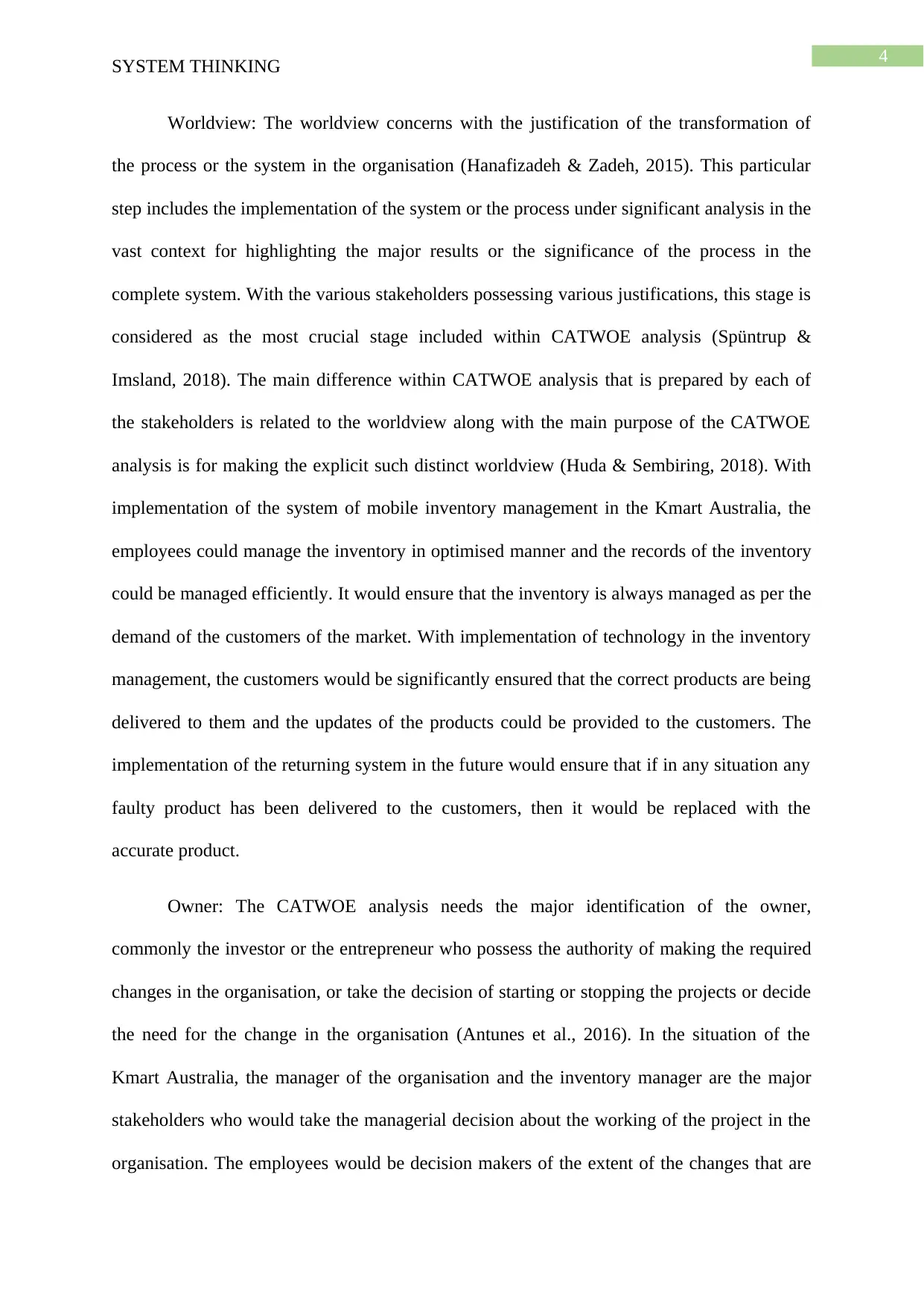
4
SYSTEM THINKING
Worldview: The worldview concerns with the justification of the transformation of
the process or the system in the organisation (Hanafizadeh & Zadeh, 2015). This particular
step includes the implementation of the system or the process under significant analysis in the
vast context for highlighting the major results or the significance of the process in the
complete system. With the various stakeholders possessing various justifications, this stage is
considered as the most crucial stage included within CATWOE analysis (Spüntrup &
Imsland, 2018). The main difference within CATWOE analysis that is prepared by each of
the stakeholders is related to the worldview along with the main purpose of the CATWOE
analysis is for making the explicit such distinct worldview (Huda & Sembiring, 2018). With
implementation of the system of mobile inventory management in the Kmart Australia, the
employees could manage the inventory in optimised manner and the records of the inventory
could be managed efficiently. It would ensure that the inventory is always managed as per the
demand of the customers of the market. With implementation of technology in the inventory
management, the customers would be significantly ensured that the correct products are being
delivered to them and the updates of the products could be provided to the customers. The
implementation of the returning system in the future would ensure that if in any situation any
faulty product has been delivered to the customers, then it would be replaced with the
accurate product.
Owner: The CATWOE analysis needs the major identification of the owner,
commonly the investor or the entrepreneur who possess the authority of making the required
changes in the organisation, or take the decision of starting or stopping the projects or decide
the need for the change in the organisation (Antunes et al., 2016). In the situation of the
Kmart Australia, the manager of the organisation and the inventory manager are the major
stakeholders who would take the managerial decision about the working of the project in the
organisation. The employees would be decision makers of the extent of the changes that are
SYSTEM THINKING
Worldview: The worldview concerns with the justification of the transformation of
the process or the system in the organisation (Hanafizadeh & Zadeh, 2015). This particular
step includes the implementation of the system or the process under significant analysis in the
vast context for highlighting the major results or the significance of the process in the
complete system. With the various stakeholders possessing various justifications, this stage is
considered as the most crucial stage included within CATWOE analysis (Spüntrup &
Imsland, 2018). The main difference within CATWOE analysis that is prepared by each of
the stakeholders is related to the worldview along with the main purpose of the CATWOE
analysis is for making the explicit such distinct worldview (Huda & Sembiring, 2018). With
implementation of the system of mobile inventory management in the Kmart Australia, the
employees could manage the inventory in optimised manner and the records of the inventory
could be managed efficiently. It would ensure that the inventory is always managed as per the
demand of the customers of the market. With implementation of technology in the inventory
management, the customers would be significantly ensured that the correct products are being
delivered to them and the updates of the products could be provided to the customers. The
implementation of the returning system in the future would ensure that if in any situation any
faulty product has been delivered to the customers, then it would be replaced with the
accurate product.
Owner: The CATWOE analysis needs the major identification of the owner,
commonly the investor or the entrepreneur who possess the authority of making the required
changes in the organisation, or take the decision of starting or stopping the projects or decide
the need for the change in the organisation (Antunes et al., 2016). In the situation of the
Kmart Australia, the manager of the organisation and the inventory manager are the major
stakeholders who would take the managerial decision about the working of the project in the
organisation. The employees would be decision makers of the extent of the changes that are
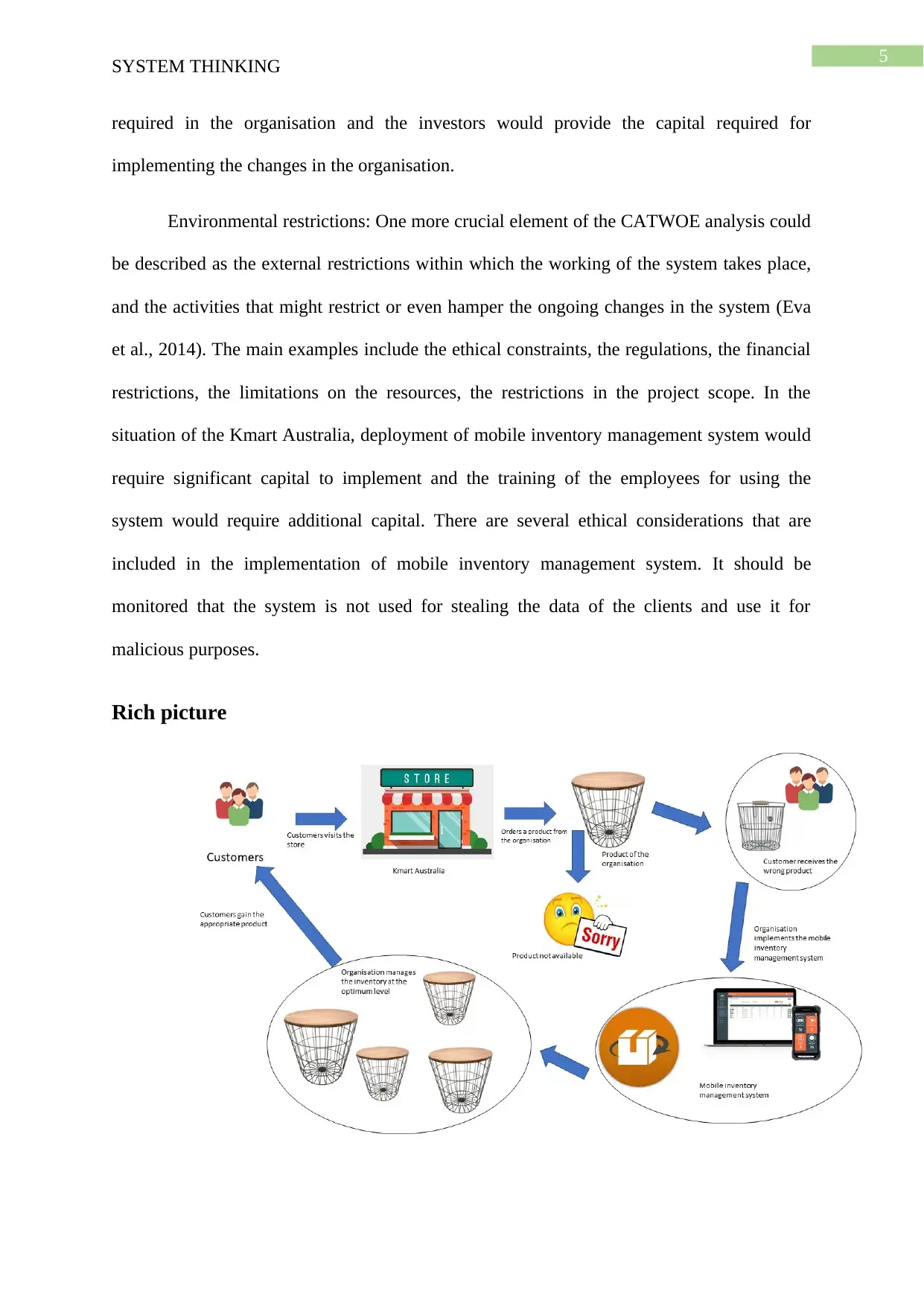
5
SYSTEM THINKING
required in the organisation and the investors would provide the capital required for
implementing the changes in the organisation.
Environmental restrictions: One more crucial element of the CATWOE analysis could
be described as the external restrictions within which the working of the system takes place,
and the activities that might restrict or even hamper the ongoing changes in the system (Eva
et al., 2014). The main examples include the ethical constraints, the regulations, the financial
restrictions, the limitations on the resources, the restrictions in the project scope. In the
situation of the Kmart Australia, deployment of mobile inventory management system would
require significant capital to implement and the training of the employees for using the
system would require additional capital. There are several ethical considerations that are
included in the implementation of mobile inventory management system. It should be
monitored that the system is not used for stealing the data of the clients and use it for
malicious purposes.
Rich picture
SYSTEM THINKING
required in the organisation and the investors would provide the capital required for
implementing the changes in the organisation.
Environmental restrictions: One more crucial element of the CATWOE analysis could
be described as the external restrictions within which the working of the system takes place,
and the activities that might restrict or even hamper the ongoing changes in the system (Eva
et al., 2014). The main examples include the ethical constraints, the regulations, the financial
restrictions, the limitations on the resources, the restrictions in the project scope. In the
situation of the Kmart Australia, deployment of mobile inventory management system would
require significant capital to implement and the training of the employees for using the
system would require additional capital. There are several ethical considerations that are
included in the implementation of mobile inventory management system. It should be
monitored that the system is not used for stealing the data of the clients and use it for
malicious purposes.
Rich picture
⊘ This is a preview!⊘
Do you want full access?
Subscribe today to unlock all pages.

Trusted by 1+ million students worldwide
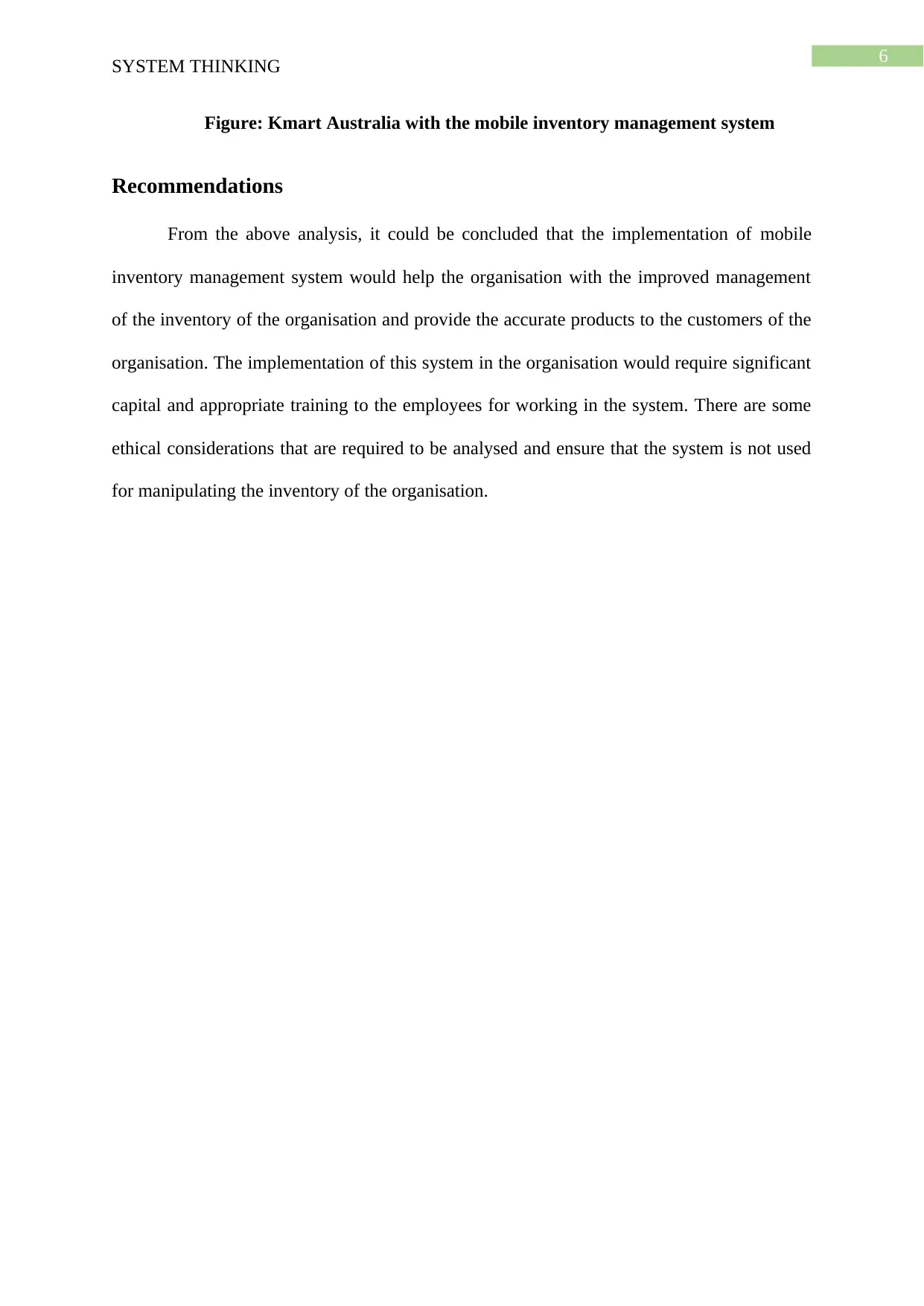
6
SYSTEM THINKING
Figure: Kmart Australia with the mobile inventory management system
Recommendations
From the above analysis, it could be concluded that the implementation of mobile
inventory management system would help the organisation with the improved management
of the inventory of the organisation and provide the accurate products to the customers of the
organisation. The implementation of this system in the organisation would require significant
capital and appropriate training to the employees for working in the system. There are some
ethical considerations that are required to be analysed and ensure that the system is not used
for manipulating the inventory of the organisation.
SYSTEM THINKING
Figure: Kmart Australia with the mobile inventory management system
Recommendations
From the above analysis, it could be concluded that the implementation of mobile
inventory management system would help the organisation with the improved management
of the inventory of the organisation and provide the accurate products to the customers of the
organisation. The implementation of this system in the organisation would require significant
capital and appropriate training to the employees for working in the system. There are some
ethical considerations that are required to be analysed and ensure that the system is not used
for manipulating the inventory of the organisation.
Paraphrase This Document
Need a fresh take? Get an instant paraphrase of this document with our AI Paraphraser
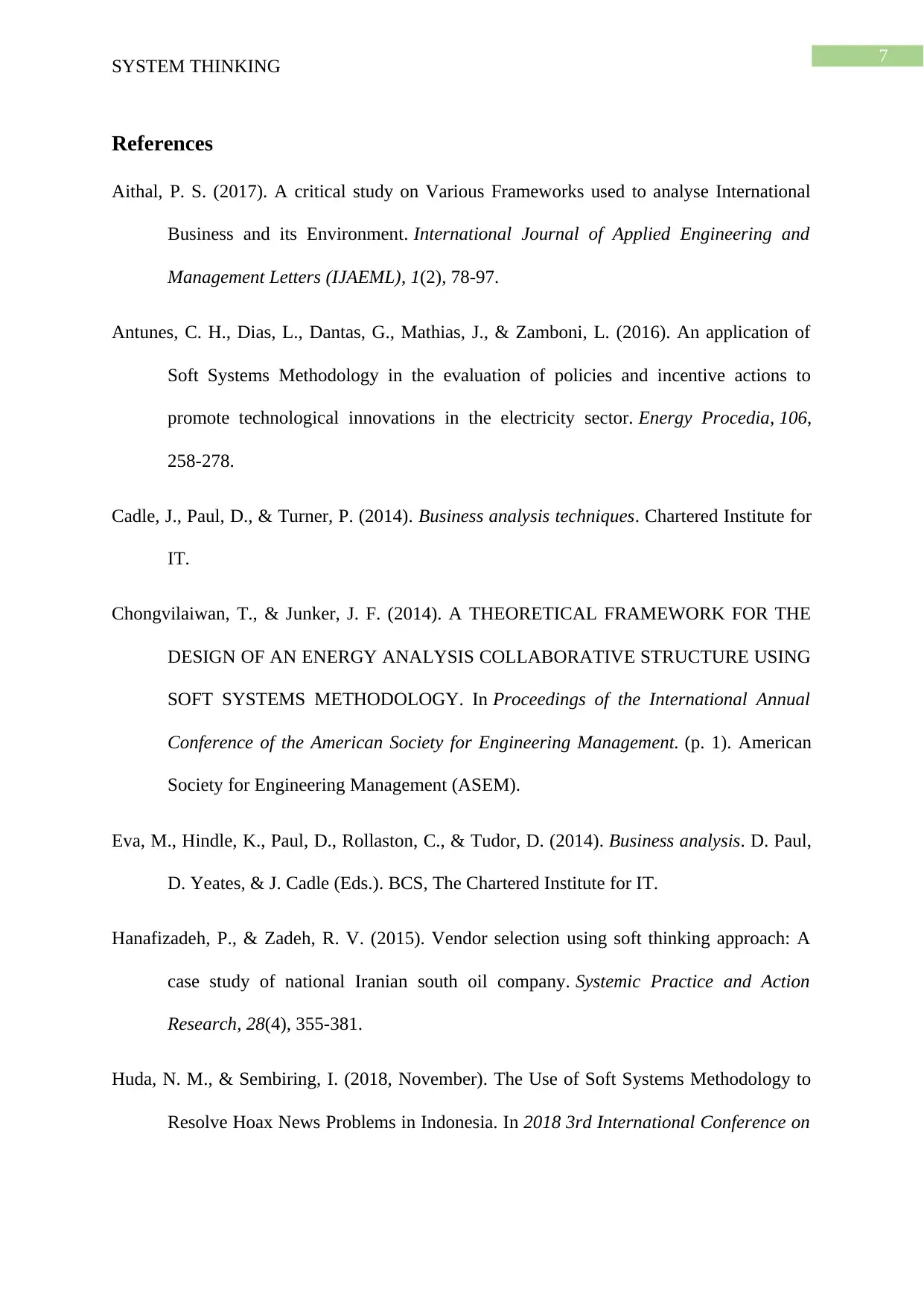
7
SYSTEM THINKING
References
Aithal, P. S. (2017). A critical study on Various Frameworks used to analyse International
Business and its Environment. International Journal of Applied Engineering and
Management Letters (IJAEML), 1(2), 78-97.
Antunes, C. H., Dias, L., Dantas, G., Mathias, J., & Zamboni, L. (2016). An application of
Soft Systems Methodology in the evaluation of policies and incentive actions to
promote technological innovations in the electricity sector. Energy Procedia, 106,
258-278.
Cadle, J., Paul, D., & Turner, P. (2014). Business analysis techniques. Chartered Institute for
IT.
Chongvilaiwan, T., & Junker, J. F. (2014). A THEORETICAL FRAMEWORK FOR THE
DESIGN OF AN ENERGY ANALYSIS COLLABORATIVE STRUCTURE USING
SOFT SYSTEMS METHODOLOGY. In Proceedings of the International Annual
Conference of the American Society for Engineering Management. (p. 1). American
Society for Engineering Management (ASEM).
Eva, M., Hindle, K., Paul, D., Rollaston, C., & Tudor, D. (2014). Business analysis. D. Paul,
D. Yeates, & J. Cadle (Eds.). BCS, The Chartered Institute for IT.
Hanafizadeh, P., & Zadeh, R. V. (2015). Vendor selection using soft thinking approach: A
case study of national Iranian south oil company. Systemic Practice and Action
Research, 28(4), 355-381.
Huda, N. M., & Sembiring, I. (2018, November). The Use of Soft Systems Methodology to
Resolve Hoax News Problems in Indonesia. In 2018 3rd International Conference on
SYSTEM THINKING
References
Aithal, P. S. (2017). A critical study on Various Frameworks used to analyse International
Business and its Environment. International Journal of Applied Engineering and
Management Letters (IJAEML), 1(2), 78-97.
Antunes, C. H., Dias, L., Dantas, G., Mathias, J., & Zamboni, L. (2016). An application of
Soft Systems Methodology in the evaluation of policies and incentive actions to
promote technological innovations in the electricity sector. Energy Procedia, 106,
258-278.
Cadle, J., Paul, D., & Turner, P. (2014). Business analysis techniques. Chartered Institute for
IT.
Chongvilaiwan, T., & Junker, J. F. (2014). A THEORETICAL FRAMEWORK FOR THE
DESIGN OF AN ENERGY ANALYSIS COLLABORATIVE STRUCTURE USING
SOFT SYSTEMS METHODOLOGY. In Proceedings of the International Annual
Conference of the American Society for Engineering Management. (p. 1). American
Society for Engineering Management (ASEM).
Eva, M., Hindle, K., Paul, D., Rollaston, C., & Tudor, D. (2014). Business analysis. D. Paul,
D. Yeates, & J. Cadle (Eds.). BCS, The Chartered Institute for IT.
Hanafizadeh, P., & Zadeh, R. V. (2015). Vendor selection using soft thinking approach: A
case study of national Iranian south oil company. Systemic Practice and Action
Research, 28(4), 355-381.
Huda, N. M., & Sembiring, I. (2018, November). The Use of Soft Systems Methodology to
Resolve Hoax News Problems in Indonesia. In 2018 3rd International Conference on
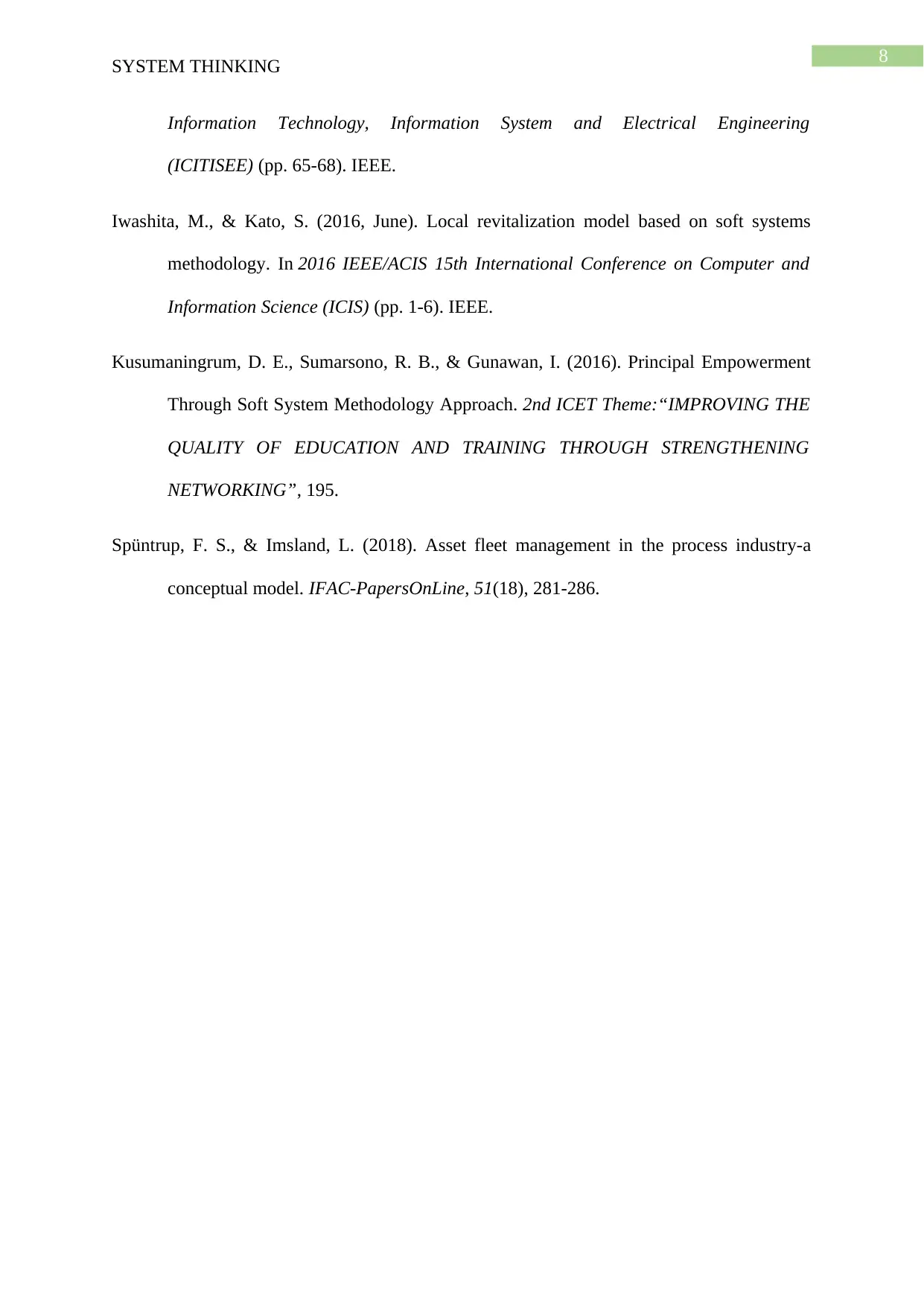
8
SYSTEM THINKING
Information Technology, Information System and Electrical Engineering
(ICITISEE) (pp. 65-68). IEEE.
Iwashita, M., & Kato, S. (2016, June). Local revitalization model based on soft systems
methodology. In 2016 IEEE/ACIS 15th International Conference on Computer and
Information Science (ICIS) (pp. 1-6). IEEE.
Kusumaningrum, D. E., Sumarsono, R. B., & Gunawan, I. (2016). Principal Empowerment
Through Soft System Methodology Approach. 2nd ICET Theme:“IMPROVING THE
QUALITY OF EDUCATION AND TRAINING THROUGH STRENGTHENING
NETWORKING”, 195.
Spüntrup, F. S., & Imsland, L. (2018). Asset fleet management in the process industry-a
conceptual model. IFAC-PapersOnLine, 51(18), 281-286.
SYSTEM THINKING
Information Technology, Information System and Electrical Engineering
(ICITISEE) (pp. 65-68). IEEE.
Iwashita, M., & Kato, S. (2016, June). Local revitalization model based on soft systems
methodology. In 2016 IEEE/ACIS 15th International Conference on Computer and
Information Science (ICIS) (pp. 1-6). IEEE.
Kusumaningrum, D. E., Sumarsono, R. B., & Gunawan, I. (2016). Principal Empowerment
Through Soft System Methodology Approach. 2nd ICET Theme:“IMPROVING THE
QUALITY OF EDUCATION AND TRAINING THROUGH STRENGTHENING
NETWORKING”, 195.
Spüntrup, F. S., & Imsland, L. (2018). Asset fleet management in the process industry-a
conceptual model. IFAC-PapersOnLine, 51(18), 281-286.
⊘ This is a preview!⊘
Do you want full access?
Subscribe today to unlock all pages.

Trusted by 1+ million students worldwide
1 out of 9
Related Documents
Your All-in-One AI-Powered Toolkit for Academic Success.
+13062052269
info@desklib.com
Available 24*7 on WhatsApp / Email
![[object Object]](/_next/static/media/star-bottom.7253800d.svg)
Unlock your academic potential
Copyright © 2020–2025 A2Z Services. All Rights Reserved. Developed and managed by ZUCOL.



